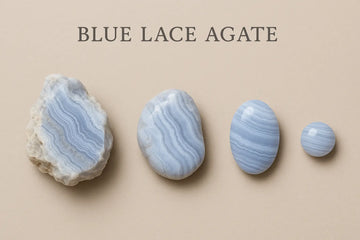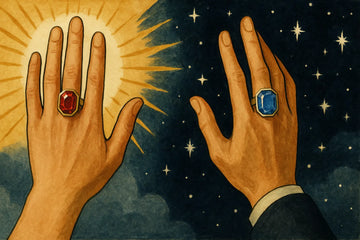In a world obsessed with the sparkle of the final gem, we often forget the artist who orchestrated the light. We see the diamond in the ring, the sapphire in the necklace, and we attribute its beauty to nature or its value to the jeweler. But between the raw, unassuming stone pulled from the earth and the dazzling jewel set in precious metal, there is a translator. A revealer of secrets. This is the lapidary.
The word itself, derived from the Latin lapis for "stone," sounds ancient because it is. The lapidary’s art is one of humanity’s oldest professions, a perfect marriage of patient artistry, profound geological understanding, and rugged technical skill. They are the unsung heroes of the gem world, the quiet masters who listen to what a stone wants to be and then, with painstaking care, help it become exactly that.
This is not merely cutting and polishing. This is a conversation with the earth.
More Than a Rockhound - The Many Faces of a Lapidary
Not all lapidaries do the same work. The field is rich with specializations, each with its own tools and goals:
The Cabochon Cutter
The master of the smooth, domed, and highly polished stone. They work with opaque gems like turquoise, malachite, opal, and star sapphires, where color and pattern are more important than sparkle. Their goal is to create a flawless, glossy dome (called a cabochon or cab for short) that seems to draw light into its depths.
The Faceter
The architect of light. They work with transparent stones like diamond, sapphire, and amethyst, cutting precise, geometric flat planes called facets. Each facet is cut to a specific angle to act like a tiny mirror, bouncing light internally and then returning it to the viewer’s eye as that explosive flash of brilliance and fire we call sparkle.
The Carver
The storyteller. These are the sculptors of the gem world. Using specialized tools, they carve intricate designs, figures, and scenes into gem materials. This can range from delicate flowers carved into jade to intricate intaglio (carved-down) or cameo (carved in relief) designs in shell or agate.
The Gemologist
While not always a hands-on cutter, the gemologist is the lapidary’s crucial counterpart. They are the forensic scientists, identifying gem species, detecting treatments and synthetics, and grading stones based on strict criteria (The 4 Cs: Color, Clarity, Cut, and Carat Weight).
The Conversation Begins - Reading the Rough
A lapidary’s work begins not with a tool, but with a long, studied look. A raw piece of gem material, known as rough, can look like a dull, ordinary rock. The lapidary’s first and most critical skill is to see past this.
They examine it under light, searching for clues:
-
Color Zones: Where is the richest concentration of color?
-
Inclusions: Internal features like crystals, fractures, or clouds. These can be flaws to avoid or, in the case of a rutile needle in a star sapphire, the very feature that must be centered to create the desired "star" effect.
-
Crystal Structure: How does the natural shape of the crystal suggest it should be cut to avoid shattering?
This phase is called orienting the stone. It’s like a sculptor looking at a block of marble and seeing the statue within. A wrong decision here can turn a potential masterpiece into worthless powder.
The Dance of Tools - From Rough to Radiant
Once the plan is set, the meticulous process begins. While technology has introduced advanced saws and lasers, the fundamental steps remain unchanged for most artisans.
-
Sawing (Trimming): Using a diamond-coated blade (diamond is the only thing hard enough to cut other gems), the lapidary removes unwanted material and cuts the rough into a more workable shape. This is the coarse work, defining the basic outline of the future gem.
-
Grinding (Shaping): The stone is then pressed against a spinning wheel, called a lap, that is coated with an abrasive grit like diamond dust. This is where the shape is formed. For a cabochon, this creates the dome. For a faceted stone, this creates the basic geometric form, called the preform.
-
Dopping: This is a quintessential lapidary term. Dopping means gluing the stone onto a small, sturdy stick (traditionally made of wood or metal and called a dop stick) with a special wax or adhesive. This gives the lapidary a handle to hold the stone securely against the grinding and polishing wheels with incredible precision.
-
Faceting or Sanding: This is where the paths diverge.
-
For a faceter, the dop stick is attached to a complex faceting machine. This machine allows them to pivot the stone to exact angles and indexes it to cut each of the dozens of facets (the table, crown, pavilion, and girdle) in perfect symmetry. One degree off, and the light will leak out instead of reflecting back, creating a "dead" stone.
-
For a cabochon cutter, the shaped stone is then sanded with progressively finer abrasives to remove all the scratches from the grinding stage, creating a smooth, satin finish.
-
-
Polishing: The final magic. Using a soft lap with a very fine polishing compound (like tin oxide or cerium oxide), the lapidary buffs the stone until it achieves its final, legendary gloss. This is the step that transforms a matte shape into a glowing, reflective jewel.
-
Final Inspection: The stone is carefully cleaned and examined under magnification. Every facet, every curve, is checked for perfection.
The Lapidary's Philosophy - Art, Science, and Soul
Being a lapidary is more than a job; it’s a philosophy. It teaches patience, for a single stone can take dozens of hours to complete. It teaches humility, as a moment of distraction can ruin weeks of work. And it teaches a deep respect for nature.
A great lapidary doesn’t force their will upon the stone. They collaborate with it. They follow its internal flaws, enhance its natural color, and unlock the optical potential hidden within its crystalline structure. They are midwives to beauty.
In our age of mass production, the lapidary stands as a guardian of slow, intentional craft. Whether they are a hobbyist working at a small bench in their garage or a master craftsman cutting a million-dollar diamond, their goal is the same: to reveal the secret soul of the stone and to set its light free.



